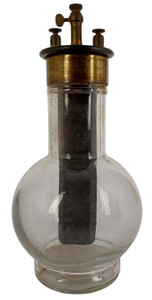
Spectacular 8.25" Circa 1880's Grenet Cell Glass Battery. An icon of early electrical history, this battery comes directly from a large collection of early electrical artifacts. There is indecipherable verbiage on the plates. The verbiage may indicate material type. Residue remains within the glass. The battery is in very good condition. The
H: 8.25"
W: 4"
History of the Grenet Cell:
A Grenet cell or bichromate cell consists of a flask like glass jar with a hard rubber, porcelain or wood cover. From the cover two flat retort carbon or graphite plates are suspended parallel with an amalgamated zinc plate hanging between them. The zinc plate is supported by a brass sliding rod which allows the zinc to be drawn entirely out of the electrolyte. The electrolyte consists of water, potassium dichromate and sulphuric acid. The E.M.F. of the cell is between 1.92 to 2.20 volts.
The cell was actually invented by German physicist Johann Christian Poggendorff in 1842. It bears the name of Eugene Grenet, Jr. of Paris, France who made it more practical. He was granted a patent in 1859.
The patent number is #25,503.











